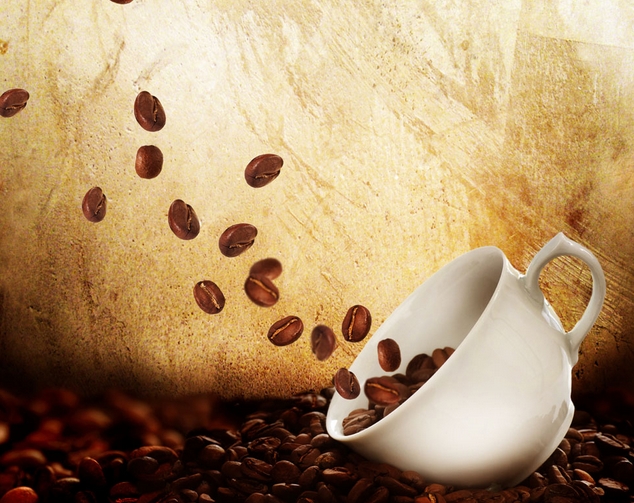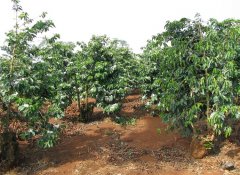From coffee beans to a cup of coffee

From coffee beans to a cup of coffee
Coffee is a plant. But before it can be drunk, it must go through several stages and travel thousands of miles.
harvest
Coffee beans are red coffee cherries from the coffee bush. Each coffee berry usually contains two types of coffee beans. The exception is male beans, where only one bean is produced. The flavor of bean production is influenced by the environment in which coffee trees and shrubs grow. Soil, climate and altitude all affect coffee taste. That's why coffee from Colombia tastes different in different regions and times
Most coffee comes from two varieties of coffee tree shrubs: Arabica coffee, referred to simply as "Arabica", and Coffea medium-fruit (variety). Robusta, abbreviated as "stout." Robusta beans are cheap, and most people buy Arabica beans because they have less caffeine and more flavor than Robusta beans!
Removal of coffee berry peel and pulp
When red coffee cherries are harvested from the coffee bush, the peel and pulp must be removed to expose the green beans inside. There are two common methods: "solarization" and "washing". The natural process of "solarization" removal tends to give coffee a rich and mild aroma, while the washing process produces a strong aromatic coffee smell.
The washing method comprises the following steps of: immersing coffee cherries in a fermentation tank for 12 - 32 hours before using a mechanical pulping machine, and then washing away residual fruit pulp and peels of mung beans to remove outer fruit pulp. Finally, let the beans dry in a sunny area for 12 to 15 days.
The coffee cherries are simply left to dry in the sun for up to four weeks. During this time, the pulp and pericarp shrivel and can then be easily removed.
grading
Coffee beans, then according to coffee bean size and coffee bean density. The bigger the coffee beans, the better. The largest coffee beans are called "fat beans" or elephant beans.
In fact, there is no uniform international coffee bean grading standard. For example, in many African countries, the highest grade coffee is AAA, while in Indonesia it is Grade 1.
baking
Green coffee beans must be roasted to make a cup of coffee. The main aroma produced during roasting is coffee. Green beans should be roasted by a skilled baker, judging by the baker's baking experience, for the time needed to produce the best flavor. Java coffee, for example, is usually roasted for a long time and is characterized by a rich and earthy flavor. However, if heated for too long, it will destroy this taste and will produce a burnt aroma and bitterness.
Coffee comes in two degrees of roasting: medium and dark. In the experience of an older barista, if you like milk chocolate, dark chocolate, then you prefer medium roast coffee.
grinding
The final step in enjoying a cup of coffee is grinding. The beans need to be ground to prepare for brewing, using the brewing method you prefer.
Different brewing methods require different degrees of grinding of coffee in order to produce the best taste. For example, using a coffee pot, you need coarse coffee powder.
Important Notice :
前街咖啡 FrontStreet Coffee has moved to new addredd:
FrontStreet Coffee Address: 315,Donghua East Road,GuangZhou
Tel:020 38364473
- Prev

Caffeine is one of hundreds of chemicals found in coffee.
Caffeine is one of hundreds of chemicals found in coffee. However, it is most infamous because it affects many people's physiology, and it is said that caffeine is harmful to the human body. In fact, caffeine is found naturally in many plants, not only in coffee shrubs, but also in plants such as tea and cocoa. Caffeine does stimulate the human spirit, which also gives
- Next

Specialty coffee is essentially fair trade, not futures.
Coffee is essentially a fair trade, not as a futures. For example, in May 2006, the Manor La Esmelada Geisha coffee, the Panamanian coffee set $50.25 per pound recorded at online auction (the award-winning coffee retails for more than $100 a pound). But Panama is only a coffee-growing country. Not only in third World countries but also in developed countries such as the University of Australia
Related
- Detailed explanation of Jadeite planting Land in Panamanian Jadeite Manor introduction to the grading system of Jadeite competitive bidding, Red bid, Green bid and Rose Summer
- Story of Coffee planting in Brenka region of Costa Rica Stonehenge Manor anaerobic heavy honey treatment of flavor mouth
- What's on the barrel of Blue Mountain Coffee beans?
- Can American coffee also pull flowers? How to use hot American style to pull out a good-looking pattern?
- Can you make a cold extract with coffee beans? What is the right proportion for cold-extracted coffee formula?
- Indonesian PWN Gold Mandrine Coffee Origin Features Flavor How to Chong? Mandolin coffee is American.
- A brief introduction to the flavor characteristics of Brazilian yellow bourbon coffee beans
- What is the effect of different water quality on the flavor of cold-extracted coffee? What kind of water is best for brewing coffee?
- Why do you think of Rose Summer whenever you mention Panamanian coffee?
- Introduction to the characteristics of authentic blue mountain coffee bean producing areas? What is the CIB Coffee Authority in Jamaica?

